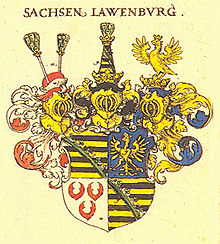
The title of Duke of Lauenburg derives from the Duchy of Saxe-Lauenburg, which, since its foundation in 1269, was ruled in succession by 29 dukes from six dynastic houses and lines, and by an additional four dukes from a temporary dynastic branch line (Anna Maria Franziska of Saxe-Lauenburg, the first would-be duchess regnant, was kept from inheriting the duchy by male rulers of neighbouring states).
The duchy was held by various countries, including France from 1803 to 1805 and from 1810 to 1814, Prussia from 1805 to 1806, and Westphalia from 1806 to 1810. The kings of Denmark, members of the House of Oldenburg, held the Duchy of Lauenburg from 1815 to 1864, when the territory came under Prussian control as a result of the Second Schleswig War, though it was not immediately annexed to Prussia.
In 1865, the estates of Saxe-Lauenburg offered rule of the duchy to King William I of Prussia. He accepted during the same year, ruling it in personal union until the estates decided upon the merger of their state with Prussia as of July 1, 1876.
After the death in 1888 of the last ruling duke, Wilhelm I (who after 1870 was also German emperor), the now purely honorific title of Duke of Lauenburg was granted to Otto von Bismarck after his dismissal as Chancellor of Germany in 1890.
- ^ The House of Wettin also adopted this coat-of-arms, when it gained Saxe-Wittenberg in 1422, which is why the Ascanian barry of ten reappears in the arms of many (formerly) Wettin-ruled states.